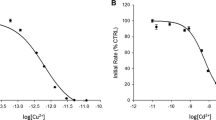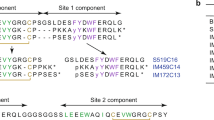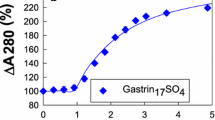Abstract
We have recently reported that fluoride interacts directly with the insulin receptor, which causes inhibition of its phosphotransferase activity. The inhibitory effect of fluoride on phosphotransferase activity is not due to the formation of complexes with aluminium and occurs in the absence of alterations to the binding of ATP or insulin. In this report we substantiate that the tyrosine kinase activity of insulin receptors partially purified from rat skeletal muscle shows a strict requirement of Mg2+ ions (Ka near 11 mM). This effect of Mg2+ was inhibited in a competitive manner by Mn2+, which is compatible with competition of both divalent ions for binding sites. The inhibition of tyrosine kinase activity caused by fluoride was dependent on the concentration of Mg2+ in the medium and no inhibitory effect was detected at low concentrations of Mg2+. Moreover, the addition of increasing concentrations of Mn2+ in the presence of a constant high concentr rease in the inhibitory effect of fluoride. These results indicate that the Mg-insulin receptor complex is the major fluoride-susceptible form. Based on the characteristics of the inhibition of tyrosine kinase shown by fluoride it might be proposed that its action is exerted by the formation of multi-ionic MgF complexes analogous to Pi, which bind to the insulin receptor kinase.
Similar content being viewed by others
References
Ebina Y, Ellis L, Jarnagin K, Edery M, Graf L, Clauser E, Ou J, Masiarz F, Kan YW, Goldfine ID, Roth RA, Rutter WJ: The human insulin receptor cDNA: The structural basis for hormone-activated transmembrane signalling. Cell 40: 747–758, 1985
Ullrich A, Bell JR, Chen EY, Herrera R, Petruzzelli LM, Dull TJ, Gray A, Coussens L, Liao YC, Tsubokawa M, Mason A, Seeburg PH, Grunfeld C, Rosen OM, Ramachandran J: Human insulin receptor and its relationship to the tyrosine kinase family of oncogenes. Nature 313: 756–761, 1985
Rosen OM: After insulin binds. Science 237: 1452–1458, 1989
Kasuga M, Karlsson FA, Kahn CR: Insulin stimulates the phosphorylation of the 95,000-dalton subunit of its own receptor. Science 215: 185–187, 1982
Kasuga M, Zick Y, Blithe DL, Karlsson FA, Haring HU, Kahn CR: Insulin stimulation of phosphorylation of the β subunit of the insulin receptor. J Biol Chem 257: 9891–9894, 1982
Petruzzelli L, Herrera R, Rosen OM: Insulin receptor is an insulin-dependent tyrosine protein kinase: Copurification of insulin-binding activity and protein kinase activity to homogeneity from human placenta. Proc Natl Acad Sci USA 81: 3327–3331, 1984
Herrera R, Rosen OM: Autophorphorylation of the insulin receptor in vitro. Designation of phosphorylation sites and correlation with receptor kinase activation. J Biol Chem 261: 11980–11985, 1986
Perlman R, Bottaro DP, White MF, Kahn CR: Conformational changes in the a-and b-subunits of the insulin receptor identified by ant peptide antibodies. J Biol Chem 264: 8946–8950, 1989
Baron V, Kaliman P, Gautier N, Van Obberghen E: The insulin receptor activation process involves localized conformational changes. J Biol Chem 267: 23290–23294, 1992
Rosen OM, Herrera R, Olowe Y, Petruzzelli LM, Cobb M: Phosphorylation activates the insulin receptor tyrosine protein kinase. Proc Natl Acad Sci USA 80: 3237–3240, 1983
Yu KT, Czech MP: Tyrosine phosphorylation of the insulin receptor β subunit activates the receptor-associated tyrosine kinase activity. J Biol Chem 259: 5277–5286, 1984
White MF, Takayama S, Kahn CR: Differences in the sites of phosphorylation of the insulin receptor in vivo and in vitro. J Biol Chem 260: 9470–9478, 1985
White MF, Kahn CR: The insulin signalling system. J Biol Chem 269: 1–4, 1994
Viñals F, Testar X, Palacín M, Zorzano A: Inhibitory effect of fluoride on insulin receptor autophosphorylation and tyrosine kinase activity. Biochem J 291: 615–622, 1993
Camps M, Gumà A, Testar X, Palacín M, Zorzano A: Insulin resistance of skeletal muscle during pregnancy is not a consequence of intrinsic modifications of insulin receptor binding or kinase activities. Endocrinology 127: 2561–2570, 1990
Bradford MM: A rapid and sensitive method for the quantitation of microgram quantities of protein utilizing the principle of protein-dye binding. Anal Biochem 72: 248–254, 1976
Avruch J, Nemenoff RA, Blackshear PJ, Pierce MW, Osathanondh R: Insulin-stimulated tyrosine phosphorylation of the insulin receptor in detergent extracts of human placental membranes. J Biol Chem 257: 15162–15166, 1982
White MF, Haring HU, Kasuga M, Kahn CR: Kinetic properties and sites of autophosphorylation of the partially purified insulin receptor from hepatoma cells. J Biol Chem 259: 255–264, 1984
Kwok YC, Nemenoff RA, Powers AC, Avruch J: Kinetic properties of the insulin receptor tyrosine protein kinase: Activation through an insulin-stimulated tyrosine-specific, intramolecular autophosphorylation. Arch Biochem Biophys 244: 102–113, 1986
Sasaki N, Rees-Jones RW, Zick Y, Nissley SP, Rechler MM: Characterization of insulin-like growth factor I-stimulated tyrosine kinase activity associated with the b-subunit of type I insulin-like growth factor receptors of rat liver cells. J Biol Chem 260: 9793–9804, 1985
Nemenoff RA, Kwok YC, Shulman GI, Blackshear PJ, Osathanondh R, Avruch J: Insulin-stimulated tyrosine protein kinase. Characterization and relation to the insulin receptor. J Biol Chem 259: 5058–5065, 1985
Pike LJ, Kuenzel EA, Casnellie JE, Krebs EG: A comparison of the insulin-and epidermal growth factor-stimulated protein kinases from human placenta. J Biol Chem 259: 9913–9921, 1984
Srivastava AK, Chiasson JL: Comparative characterization of receptor and non-receptor associated protein tyrosine kinases. Biochim Biophys Acta 996: 13–18, 1989
Smith RM, Martell AE: Critical Stability Constants. Plenum Press, New York, 1976
Antonny B, Bigay J, Chabre M: A novel magnesium-dependent mechanism for the activation of transducin by fluoride. FEBS Lett 268: 277–280, 1990
Antonny B, Sukumar M, Bigay J, Chabre M, Higashijima T: The mechanism of aluminum-dependent G-protein activation by fluoride and magnesium. J Biol Chem 268: 2393–2402, 1993
Murphy AJ, Coll RJ: Fluoride is a slow, tight-binding inhibitor of the calcium ATPase of sarcoplasmic reticulum. J Biol Chem 267: 5229–5235, 1992
Author information
Authors and Affiliations
Rights and permissions
About this article
Cite this article
Viñals, F., Camps, M., Testar, X. et al. Effect of cations on the tyrosine kinase activity of the insulin receptor: Inhibition by fluoride is magnesium dependent. Mol Cell Biochem 171, 69–73 (1997). https://doi.org/10.1023/A:1006836001489
Issue Date:
DOI: https://doi.org/10.1023/A:1006836001489




